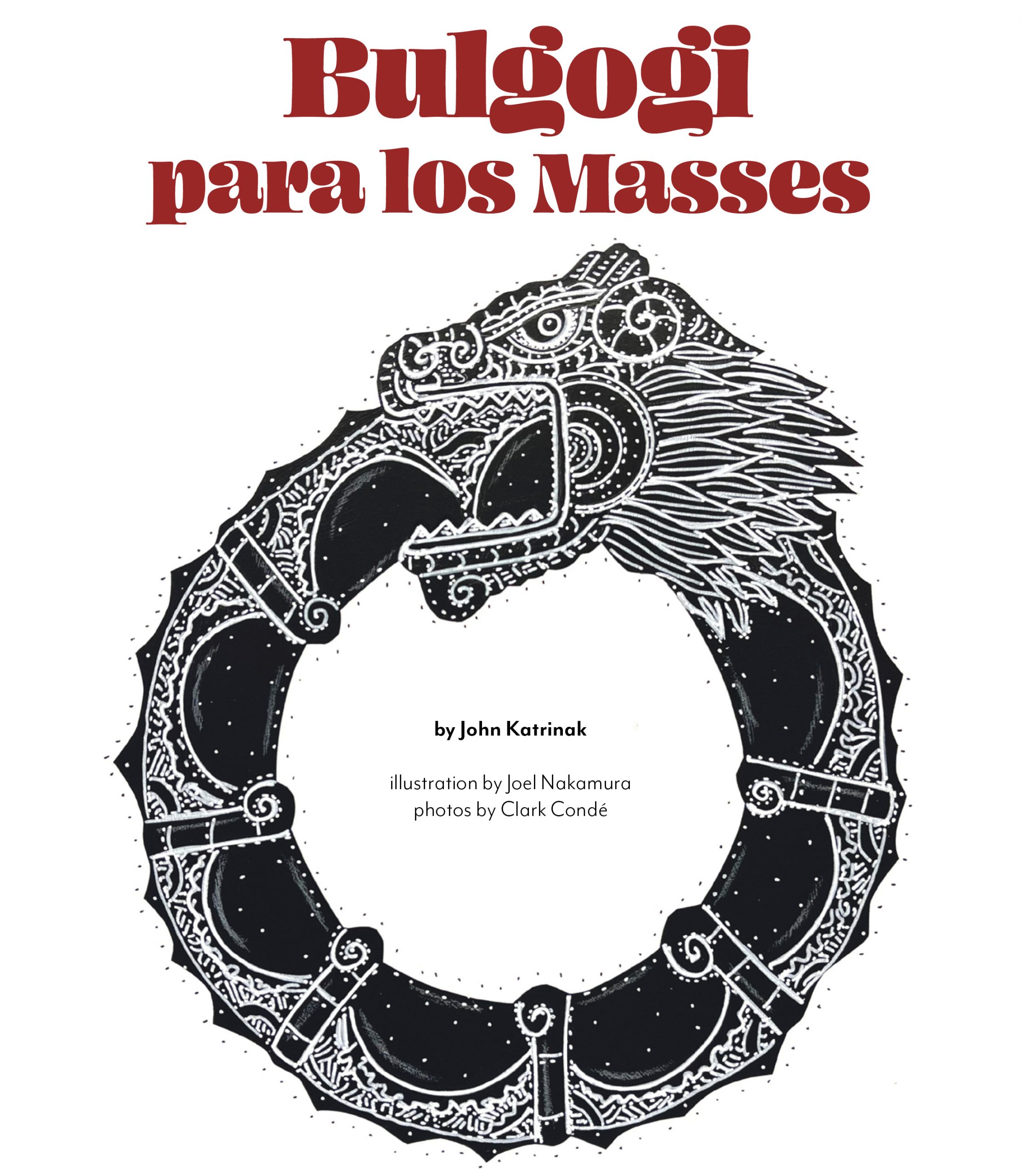
by John Katrinak
illustration by Joel Nakamura
photos by Clark Condé
Al pastor, carnitas, asada, barbacoa, and bulgogi! Did I read that right—bulgogi?
In its simplest form, a tortilla, some filling, and salsa create a craveable snack—one that can be enjoyed standing up outside a taco cart or while sipping sotol in a high-end restaurant, and everywhere in between. A dish that holds an entire nation rolled up in a tortilla can be seen in Albuquerque, cruising Fourth Street from Tacos Mex Y Mariscos in the North Valley to El Taco de Mexico in Barelas. According to one theory, you can trace the taco’s origins to the silver-mining cities in Mexico, where miners wrapped gunpowder in paper for explosive charges (these charges were called “tacos”). From there, it evolved neighborhood by neighborhood to eventually morph into the present-day flavor bombs we stuff in our mouths. When a dish holds such an impact on a culture, as the taco does for Mexico and its diaspora, how does an outsider present their perspective and passion while creating that perfect taco? This was the question I asked myself when I was first working out the menu for Soo Bak Seoul Bowl. How could I create a bite to hit all the aspects of great cooking—salt, fat, acid, and herb or spice? I researched, I ate, I created, and, lo and behold, the bulgogi beef taco was born.
The first step to creating the best taco is finding the right tortilla. No offense to wheat, but I wanted to go classic—and gluten free. My journey in search of the best corn tortilla in Albuquerque led me across the river to Tortilleria Cuauhtemoc off of Bridge and Isleta. Walking in, I was plunged into a world of masa. Packed with breads, tortillas, and Mexican candies, the tiny shop transported me, the rich scent of toasty corn calling to mind any abuela in her kitchen, toasting up fresh tortillas with a comal. Warm, soft, full of corn flavor, and pressed to the perfect thickness, best enjoyed with a pat of butter, or New Mexican style with a whole green chile, these are some of the best tortillas you can buy.
Once I’d found my wrap, I could concentrate on the filling. To every Korean, kimchi is king, but coming in a close second is barbecue. Growing up in a Korean household, we devoured a lot of Korean barbecue, from sizzling slices of pork belly eaten directly off the flat top griddle to soy-marinated beef short ribs (kalbi) grilled at high heat to the most global of them all: thinly sliced and soy-marinated bulgogi beef. My mom still uses the canned bulgogi sauce you can find at any Korean market, but my goal was to start with a base of gluten-free soy sauce, with some rice wine to thin it out. A little sugar for that sweet-salty effect. Cold-pressed sesame oil for its intense nuttiness, a little something secret, and fresh onions, garlic, and apples to help round out the savory notes and add a little natural caramelization when the beef sizzles on the grill. The bulgogi was always going to be the star, but any good taco has toppings that pop visually and in texture and flavor. Thinly sliced lettuce and aged cheddar cheese were easy classic taco toppings to choose. While Koreans don’t typically eat dairy, the effect of soy sauce and aged sharp cheddar cheese makes for double umami from the calcium lactate crystals and the fermented soy, and sends your taste buds into a tizzy.
Traditionalists will say every taco needs salsa, and I agree, but to make it all come together, I wanted to combine something familiar with something new. In a wide array of Asian hot sauces, the iconic rooster bottle of Sriracha stands out. Chili heat, along with garlic, sugar, and vinegar, makes it a perfect addition to any dish, especially in Asian cuisine. To help cut the heat, I decided on sour cream—not just any sour cream, but crema la chona, an acidified Mexican table cream. With a mix of fat, acid, and a little bit of salt, the crema hits your taste buds with notes that you didn’t even know you were missing—creamy, tangy, fatty, and sweet. Combining the two sauces helps to round it out and include all the aspects of great cooking I was searching for in the recipe for a Korean-fusion bulgogi taco.
Probably the greatest thing in creating something is seeing someone else enjoy it. Whether by the standard three-pack or the nine-pack, these simple creations have the proven power to turn my customers into friends. From a full house on a Taco Tuesday to a food-truck-lined park filled with families to a couple enjoying our tacos while knocking back a couple beers at a local brewery, food brings us together. It tells a story that breaks down barriers and makes us slow down and enjoy this moment. At Soo Bak, we put a stamp on our community, while supporting other local businesses and inviting our new friends to enjoy those last rays of a New Mexico sunset, one bulgogi taco at a time.

John Katrinak
Award-winning chefJohn Katrinaklearned the love of food from his grandmother. You can find him creating traditional and fusion Korean cuisine at his restaurant, Soo Bak Seoul Bowl in Albuquerque’s Nob Hill.











